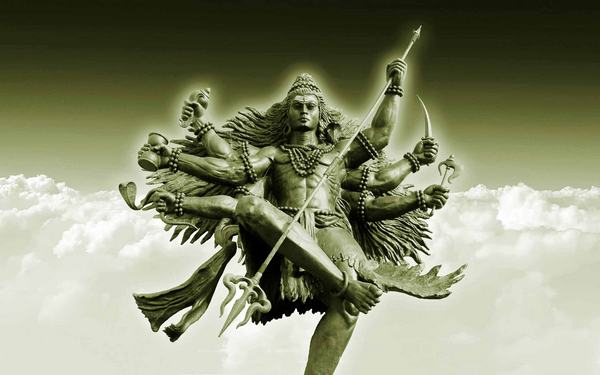“The universal life is like an immense sacrifice. God himself is the lord of the sacrifice. God is Shiva, and Nature is Uma. Though she carries the image of Shiva in her heart, still she misses his visible form; she yearns for his tangible body. This yearning is the deep significance of the universal life.”
Sri Aurobindo [Bengali Writings: 46-47]
The legends of Shiva and his Shakti are well-known in Indian lore. As the story goes, Shiva separates from His Shakti so as to let Her enter into creation. She is the power that has gone into creation. He then withdraws into deep trance, oblivious of the world. To bring him out of his trance so as to keep the balance of the world, Vishnu the preserver prays to the Divine Mother to come down and rescue creation out of the inevitable state of chaos towards which it is tending to in the absence of Shiva.

The Divine Mother assumes two forms, one of Ignorance, Sati and the other of Knowledge, Uma. Sati holds the Truth in her heart but is self-bound by the laws of Ignorance created by her father, Daksha Prajapati, one of the formateurs given the task of cosmic management. Feeling himself specially chosen and powerful Daksha spares no opportunity to belittle Shiva. Shiva however remains self-absorbed in his trance oblivious of creation and its cosmic managers. The Divine Mother born in Daksha’s house as Sati feels naturally drawn to Shiva and eventually marries him despite the resistance and refusal of her father.
The father, Daksha, then performs a cosmic yagna to give each element of creation its due share. However he refuses to give the due share to Shiva, the husband of his daughter Sati. Sati is furious at this insolence and, assuming her divine form, offers her body itself as a sacrifice in the yagna of her father. On knowing about this, Shiva’s emanations destroy the yagna, and Shiva himself, assuming his Rudra aspect, beheads Daksha. Later, at the request of the gods, he does revive Daksha but with a goat’s head affixed to his torso. Now the peculiar thing about this head is that it is fixed in the opposite way so that when the head looks forward the feet point backwards and vice versa, creating a confusion.
Meanwhile after a long gap, Sati is reborn as Uma Parvati. She undertakes lot of penance to appease Shiva who had once again plunged into trance of self-oblivion. To bring him out of his trance the gods conspire and with the help of Kamadeva, the god of vital love, pierce arrows of love into Shiva’s heart. Shiva eventually emerges but even as he casts his gaze on Kamadeva with his third eye, the body of Kamadeva is burnt but his consciousness remains becoming impersonal and universal. Shiva then beholds Uma Parvati and pleased with her penance, marries her.
This is the story in brief without the several details that have been added to it over the course of time. The story is one of the many deeply symbolic stories from Indian myth. Shiva is the masculine divine principle or the Knowledge of the One, whereas Sati and Uma represent the feminine principle, the Shakti or Power of the One. The masculine element or the Purusha is the Spirit and Soul, the feminine element is Nature, which on its peaks is one with the Lord as His Shakti but here, seems to be separated and becomes material Nature. Together they build creation. When they are not in perfect rhythm, there is chaos and destruction. But when the two dance in perfect rhythm and union there is beauty and a harmonious creation.
The first creation is a creation in Ignorance with Daksha or the mind-born ego-driven old consciousness, and it ends in a fiasco, wherein a step forward becomes actually a step backwards. It is a creation of Ignorance where falsehood has taken hold and is destined to be destroyed and rebuilt on a truer basis. Therefore Sati sacrifices her body and emerges as Uma.
Through intense tapasya, She reclaims all Her Powers and thus uniting with Shiva opens the doors to a New creation, based on Truth. In this new creation Shiva representing the Spirit and Shakti representing Nature shall unite in a perfect and harmonious embrace. It is this that is symbolized in the famous Shivalingam that is the object of reverence in Indian households
WORDS OF THE MOTHER
From “Mother You Said So”, comp. Huta, entry 08-11-1957
The Message Of Jan 1958 given by the Mother for the New Year:
O Nature, material Mother,
Thou hast said that thou wilt collaborate,
and there is no limit to the splendour of this collaboration.
The next morning the Mother sent me [Huta] a huge card illustrating Shiva and Shakti. She had written on it:
This can be taken as one aspect of the collaboration between the Spiritual Power and the Material Nature.
WORDS OF SRI AUROBINDO
Shiva
On the white summit of eternity
A single Soul of bare infinities,
Guarded he keeps by a fire-screen of peace
His mystic loneliness of nude ecstasy.
But, touched by an immense delight to be,
He looks across unending depths and sees
Musing amid the inconscient silences
The Mighty Mother’s dumb felicity.
Half now awake she rises to his glance;
Then, moved to circling by her heart-beats’ will,
The rhythmic worlds describe that passion-dance.
Life springs in her and Mind is born; her face
She lifts to Him who is Herself, until
The Spirit leaps into the Spirit’s embrace.



About Savitri | B1C1-09 Advent of the Divine Mother (p.4)